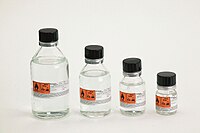
A computational foray into the mechanism and catalysis of the adduct formation reaction of guanine with crotonaldehyde
Sign Up to like & getrecommendations! Published in 2019 at "Journal of Computational Chemistry"
DOI: 10.1002/jcc.25595
Abstract: Crotonaldehyde, a common environmental pollutant and product of endogenous lipid peroxidation, reacts with guanine to form DNA adducts with pronounced genotoxicity and mutagenicity. Here, we explore the molecular mechanism of this adduct formation using double‐hybrid… read more here.
Keywords: mechanism; addition; adduct; reaction ... See more keywords

Limonene protects osteoblasts against methylglyoxal-derived adduct formation by regulating glyoxalase, oxidative stress, and mitochondrial function.
Sign Up to like & getrecommendations! Published in 2017 at "Chemico-biological interactions"
DOI: 10.1016/j.cbi.2017.10.001
Abstract: Methylglyoxal (MG) is a potent protein glycating agent and an important precursor of advanced glycation end products, which are involved in the pathogenesis of diabetic osteopathy. In this study, we investigated the effects of limonene… read more here.
Keywords: glyoxalase; adduct formation; limonene protects; limonene ... See more keywords

Syntheses, characterization, and computational study of AsF5 adducts with ketones
Sign Up to like & getrecommendations! Published in 2019 at "Journal of Fluorine Chemistry"
DOI: 10.1016/j.jfluchem.2019.02.011
Abstract: Abstract Lewis acid-base adducts between AsF5 and the ketones, acetone, cyclopentanone, and adamantanone, were synthesized from SO2 and CH2Cl2 solutions. These adducts, which contain O---As pnictogen bonding interactions, were found to be stable in solutions… read more here.
Keywords: characterization computational; spectroscopy; syntheses characterization; adduct formation ... See more keywords

Synergistic Interaction of Polycyclic Aromatic Hydrocarbons, Phthalate Esters, or Phenol on DNA Adduct Formation by Aristolochic Acid I: Insights into the Etiology of Balkan Endemic Nephropathy.
Sign Up to like & getrecommendations! Published in 2022 at "Chemical research in toxicology"
DOI: 10.1021/acs.chemrestox.2c00026
Abstract: Balkan endemic nephropathy (BEN) is a multifactorial environmental disease, with chronic exposure to aristolochic acids (AAs) through AA-contaminated food being one of the major etiological mechanisms. However, the bulk of previous research has only focused… read more here.
Keywords: balkan endemic; adduct formation; etiology; dna adduct ... See more keywords

Interindividual Differences in DNA Adduct Formation and Detoxification of 1,3-Butadiene Derived Epoxide in Human Hapmap Cell Lines.
Sign Up to like & getrecommendations! Published in 2020 at "Chemical research in toxicology"
DOI: 10.1021/acs.chemrestox.9b00517
Abstract: Smoking-induced lung cancer is a major cause of cancer mortality in the US and worldwide. While 11-24 % of smokers will develop lung cancer, risk varies among individuals and ethnic/racial groups. Specifically, African American and… read more here.
Keywords: cell lines; butadiene; dna adduct; lung cancer ... See more keywords

Diminishing GSH-Adduct Formation of Tricyclic Diazepine-based Mutant IDH1 Inhibitors.
Sign Up to like & getrecommendations! Published in 2022 at "ACS medicinal chemistry letters"
DOI: 10.1021/acsmedchemlett.2c00089
Abstract: Mutant isocitrate dehydrogenase 1 (IDH1) has been identified as an attractive oncology target for which >70% of grade II and III gliomas and ∼10% of acute myeloid leukemia (AML) harbor somatic IDH1 mutations. These mutations… read more here.
Keywords: tricyclic diazepine; mutant idh1; adduct formation; gsh adduct ... See more keywords

Static quenching upon adduct formation: a treatment without shortcuts and approximations.
Sign Up to like & getrecommendations! Published in 2021 at "Chemical Society reviews"
DOI: 10.1039/d1cs00422k
Abstract: Luminescence quenching is a process exploited in transversal applications in science and technology and it has been studied for a long time. The luminescence quenching mechanisms are typically distinguished in dynamic (collisional) and static, which… read more here.
Keywords: upon adduct; formation; quenching upon; adduct formation ... See more keywords

Co-Exposure to Aristolochic Acids I and II Increases DNA Adduct Formation Responsible for Aristolochic Acid I-Mediated Carcinogenicity in Rats
Sign Up to like & getrecommendations! Published in 2021 at "International Journal of Molecular Sciences"
DOI: 10.3390/ijms221910479
Abstract: The plant extract aristolochic acid (AA), containing aristolochic acids I (AAI) and II (AAII) as major components, causes aristolochic acid nephropathy (AAN) and Balkan endemic nephropathy (BEN), unique renal diseases associated with upper urothelial cancer.… read more here.
Keywords: dna adduct; aai aaii; adduct formation;

Stereoselective Covalent Adduct Formation of Acyl Glucuronide Metabolite of Nonsteroidal Anti-Inflammatory Drugs with UDP-Glucuronosyltransferase
Sign Up to like & getrecommendations! Published in 2022 at "International Journal of Molecular Sciences"
DOI: 10.3390/ijms23094724
Abstract: A reactive metabolite of nonsteroidal anti-inflammatory drugs (NSAIDs), acyl-β-D-glucuronide (AG), covalently binds to endogenous proteins. The covalent adduct formation of NSAIDs-AG may lead to the dysfunction of target proteins. Therefore, it is important to clarify… read more here.
Keywords: adduct formation; covalent adduct; covalent; metabolite nonsteroidal ... See more keywords